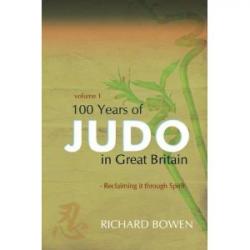100 Years of Judo in Great Britain: Reclaiming of Its True Spirit (Volumes 1 & 2)

By Richard Bowen
Indepenpress Publishing Ltd, 2011
428 pages (Volume 1)
506 pages (Volume 2)
ISBN-13: 978-1907499319 (Volume 1)
ISBN-13: 978-1780030104 (Volume 2)
Review by Peter Brunning
The late Richard Bowen was an accomplished student and instructor of judo. Bowen was also an indefatigable researcher into the history of judo in this country. He amassed a considerable archive of letters, photographs and other documentary records (which are now held in the Richard Bowen Collection at the University of Bath). His two volume history is a pleasingly written and the combined work runs to nearly 1000 pages.
The history starts with the arrival of the Tani brothers in this country from Kobe in September 1900 aboard the Wakasa Maru. Yukio Tani [谷 幸雄] and his brother had been invited to England by E.W. Barton-Wright who had established a “School of Arms” in Shaftesbury Avenue London. Barton-Wright had worked and lived in Japan and developed an integrated style of unarmed combat which he called “Bartitsu,” on which he lectured to the Japan Society in 1901.
Tani broke with Barton-Wright around 1903 and then participated in challenge contests in music hall, from which he earned (and lost) a considerable amount of money. The book discusses some of his contests and also the various judo schools that were established in London at that time (those at Golden Square and in Oxford Street).
In 1918 The Budokwai [武道会] club was formed by Gunji Koizumi [小泉 軍治] who had arrived in this country in 1906 and later established a business in Japanese lacquer ware. Bowen calculates that by the end of its first year the club was in debt to Koizumi to the extent of some £4000. Tani was engaged as its chief instructor. There are fascinating descriptions of Budokwai personalities (E.J. Harrison, T.P. Leggett) and of significant events in its history e.g. the visit of British based judoka to Germany in 1929 and, more controversially, to the same country in 1933.
The narrative brings out very well the personalities of some of those involved; the diplomatic secretary to the Budokwai (Harold Tricker) and that of Koizumi, its inspirational founder and guiding light, who strongly believed that judo and judo training had an ethical dimension.
The second volume opens with the very moving final pages of Koizumi’s diary, shortly before his premeditated suicide in 1965. It then takes up the history of The Budokwai and the club’s somewhat hand to mouth existence during the interwar period. At one stage Koizumi resigns before he feels the Club should stand it its own two feet (Bowen says it was many years before he formally “unresigned”). In 1929 Tani felt he had been badly treated by the club and it was left to Tricker to pacify him. There are tales of visiting Japanese personalities of the formation of international judo organisations. There is little on judo after the 1950s and hints that Bowen himself thought that competitions were given too much emphasis in modern British judo, to the detriment of the character building element.
The work contains many references to material in the fascinating archive at the University of Bath, which is evidence of Bowen’s huge achievement in assembling material on the development of this martial art in this country. In the text that we have, the love of a good anecdote sometimes gets in the way of the purely narrative or historical needs of the work. I am sure that the author would have revised and re-arranged some of the material and provided a much-needed index had time allowed. What we do have, both in the book and in the archive, is a source of information and insight for which anyone who has an interest in judo and for that we can be very grateful.

